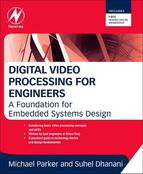1
Video in the Modern World
Video began as a purely analog technology. Successive images were captured on film streaming through the camera. The movie was played by using flashes of light to illuminate each frame on the moving film, at rates sufficient to show continual motion. Flicker, however, was easily seen.
An improved system for early broadcast television utilized the luminance (or light intensity) information represented as an analog signal. To transmit an image, the luminance information was sent in successive horizontal scans. Sufficient horizontal scans built up a two-dimensional image. Televisions and monitors used cathode ray guns that shot a stream of electrons to excite a phosphorus-coated screen. The slowly fading phosphorus tended to eliminate flicker. The cathode gun scanned in successive rows, each row just below the previous row, guided by magnetic circuits. This happened so rapidly that images were “painted” at a rate of 25 to 30 frames per second (fps). The luminance signal was used to control the intensity of the electron stream.
A horizontal synchronization signal is used to separate the horizontal scan periods. The horizontal sync period is a short pulse at the end of each scan line. This has to be long enough to allow the electron gun to move back to the left side of the screen, in preparation for the next scan line. Similarly, the vertical synchronization signal occurs at the end of the last or bottom scan, and is used to separate each video frame. The vertical synchronization interval is much longer, and allows the electron gun to move back up from the lower right corner of the screen to the upper left corner, to begin a new frame.
Later, color information in the form of red and blue hues was added, known as chrominance information. This was superimposed on the luminance signal, so that the color system is backwards compatible to the black-and-white system.
Modern video signals are represented, stored and transmitted digitally. Digital representation has opened up all sorts of new usages of video. Digital video processing is of growing importance in a variety of markets such as video surveillance; video conferencing; medical imaging; military imaging including UAVs (Unmanned Aerial Vehicles), weapons sights and night vision; broadcast; digital cinema; industrial displays and consumer electronics. All these sectors are embarking on a massive decade-long upgrade cycle from standard definition to HD-and higher than HD-resolution video processing. In some cases the old analog video-processing equipment is being replaced by systems using digital techniques.

Figure 1.1 Video raster scan.
In many cases, industries that have not traditionally been involved in video processing must now integrate this technology into their products. Examples are rear cameras, entertainment centers, “lane departure” and “head-up” displays in automotives; video data handling in networking servers and routers; sharing and merging of video to provide situational awareness in military systems; surveillance and guidance in military and commercial airborne systems; robotic systems; facial and other features recognition (such as license plates) in security surveillance systems and myriad other applications. This trend is placing new requirements on system designers as well as implementation engineers to understand video technology. This book is designed for those individuals who need to understand basic concepts and applications, so that they can either build their own video systems, or integrate third-party video technology into their products.
Another target audience is those involved in technical marketing and sales and executives from the many industries requiring video technology. Again, the need is to understand basic concepts and applications, without being overwhelmed by the details and implementation complexity.
The market sizes of these new video applications are growing rapidly. For example, here are some publically available projections:
• ABI Research believes that the video surveillance market is poised for explosive growth, which the firm forecasts to expand from revenue of about $13.5 B in 2006 to a remarkable $46 B in 2013. Those figures include cameras, computers and storage, professional services, and hardware infrastructure: everything that goes into an end-to-end security system.
• According to Wainhouse Research, the overall endpoint market for video conferencing will grow from $1.3 B in 2007 to over $4.9 B in 2013. Videoconferencing infrastructure product revenues, including MCUs, gateways, and gatekeepers, are forecast to grow to $725 M over the same period.
• HD penetration rates: there is still a lot of work to be done to develop, store, edit and transmit HD signals within both the USA and Europe.
Digital cinema is ramping up within the next five years – 10,000 US theaters are to be upgraded in 2010–2011. Digital cinemas drive significant design activity in HD and 4K video processing.
The $16 B US medical-imaging product industry will grow six percent annually in the course of 2010 based on technological advances, aging demographics and changing health care approaches. Equipment will outpace consumables, led by CT scanners and by MRI and PET machines.
All of these trends and many more lead us to believe that there is a tremendous and growing demand for a book that demystifies video processing. Professional engineers, marketers, executives and students alike need to understand:
• What is video - in terms of colors, bits and resolutions?
• What are the typical ways that video is transported?
• What functions are typical in video processing - scaling, deinterlacing, mixing?
• What are the typical challenges involved in building video-processing designs - frame buffering, line buffering, memory bandwidth, embedded control, etc.?
These concepts provide a solid theoretical foundation upon which the reader can build their video knowledge. This book intends to be the first text on this subject for these engineers/students.
